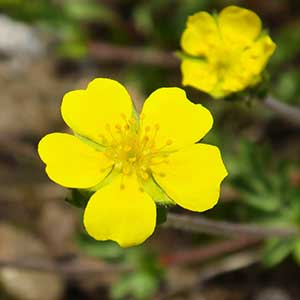Potentilla versicolor
Rosaceae subfam. rosoideae
Steens Mountain cinquefoil, varying cinquefoil
prostrate to ascending, (0.7–)1.5–2.5(–4) dm, lengths 2–4(–5) times basal leaves.
alternate, rarely opposite, pinnately compound, sometimes simple or palmately compound;
stipules present, rarely absent.
pinnate with distal leaflets ± confluent, 4–12 × 1–2.5(–3.5) cm;
petiole 1–3 cm, straight hairs absent (on early-season petioles) or sparse to common, spreading-ascending to loosely appressed, 1–2 mm, soft, cottony hairs usually absent, glands sparse;
primary lateral leaflets 3–5 per side, on distal (1/3–)1/2–2/3 of leaf axis, overlapping, largest ones cuneate to flabellate, 0.5–1.5(–2) × 0.5–1.5 cm, distal 3/4 to whole margin unevenly incised 2/3 to completely to midvein (blade often medially split as well), ultimate teeth or segments 2–5(–8), ± oblanceolate, 3–11 × 1–3 mm, apical tufts to 1 mm, surfaces green to grayish green, not glaucous, straight hairs sparse to common (sparser adaxially), sometimes absent (except on margins), loosely appressed to ascending, 1–2 mm, soft, cottony hairs absent, glands sparse to common.
1–2(–3).
(1–)3–10-flowered, usually openly cymose.
1–3(–5) cm, straight to slightly recurved in fruit.
epicalyx bractlets lanceolate to elliptic, rarely ovate, 2–5 × 1–2 mm, sometimes apically toothed;
hypanthium 3–5 mm diam.;
sepals 4–7 mm, apex acute;
petals 4–7 × 3–5.5 mm;
filaments (1–)1.5–2.5 mm, anthers 0.5–0.8 mm;
carpels 10–25, styles 2 mm.
torus usually enlarged, sometimes small or absent;
carpels 1–260(–450), distinct, free, styles distinct, rarely connate (Roseae);
ovules 1(or 2), collateral (Rubeae) or superposed (Fallugia, Filipendula).
achenes or aggregated achenes sometimes with fleshy, urn-shaped hypanthium or enlarged torus, sometimes aggregated drupelets;
styles persistent or deciduous, not elongate (elongate but not plumose in Geum).
1.5–1.8 mm, smooth to faintly rugose, not carunculate.
= 7(8).
Potentilla versicolor
Rosaceae subfam. rosoideae
Potentilla versicolor is most common on Steens Mountain in Harney County, Oregon. Collections are known from other mountain ranges in eastern Oregon (some possibly representing distinct taxa) and from near Island Lake in the Ruby Mountains of northeastern Nevada. The species often grows and, apparently, intergrades with P. breweri; it is usually distinct in its lack of cottony hairs. Petals, filaments, and styles tend to be somewhat shorter in P. versicolor than in P. breweri. Collections of P. versicolor have most often been identified as P. breweri, P. millefolia, or P. ovina.
(Discussion copyrighted by Flora of North America; reprinted with permission.)
Variation in the number of genera in subfam. Rosoideae is due to differences in generic delimitation between D. Potter et al. (2007) and the authors of some Potentilleae genera. Cyanogenic glycosides and sorbitol are absent in the subfamily.
Tribes 6, genera 28–35, species ca. 1600 (6 tribes, 26 genera, 302 species, including 1 hybrid, in the flora)
(Discussion copyrighted by Flora of North America; reprinted with permission.)


